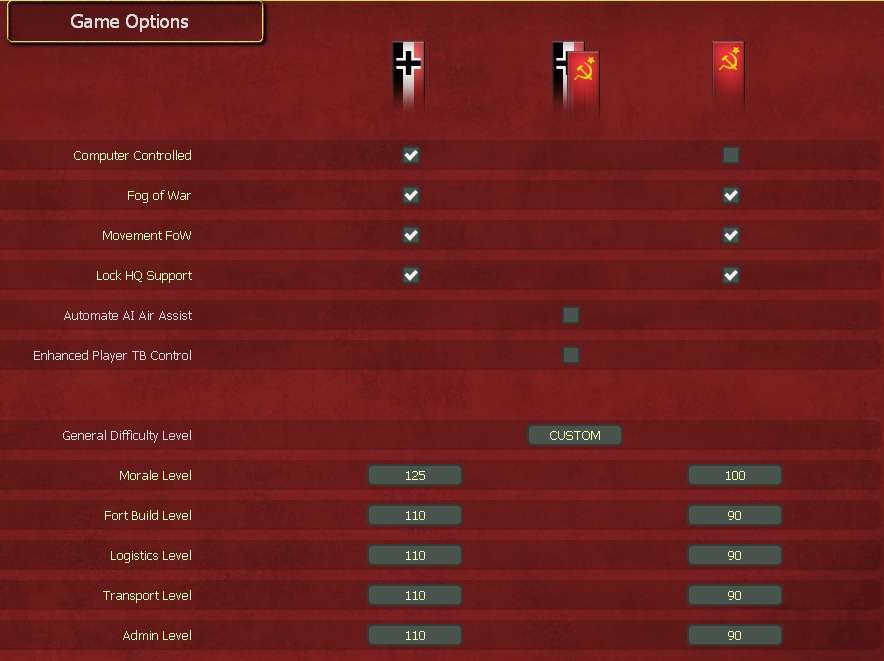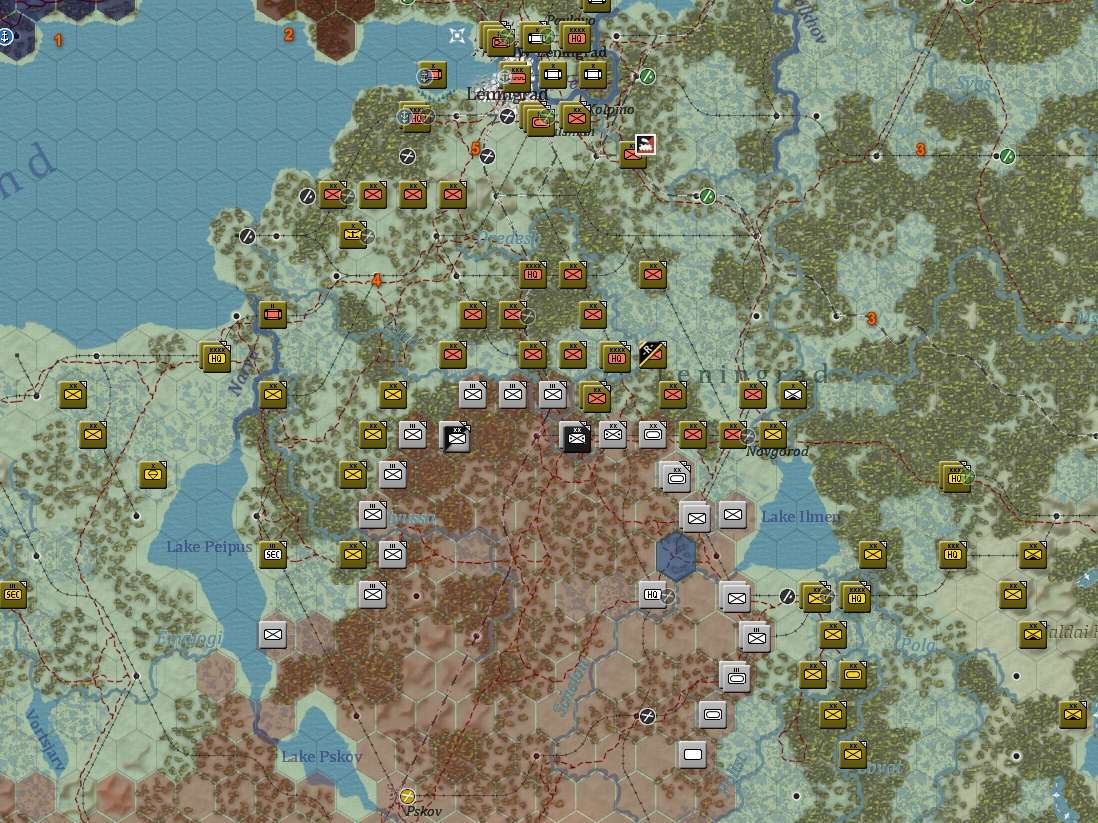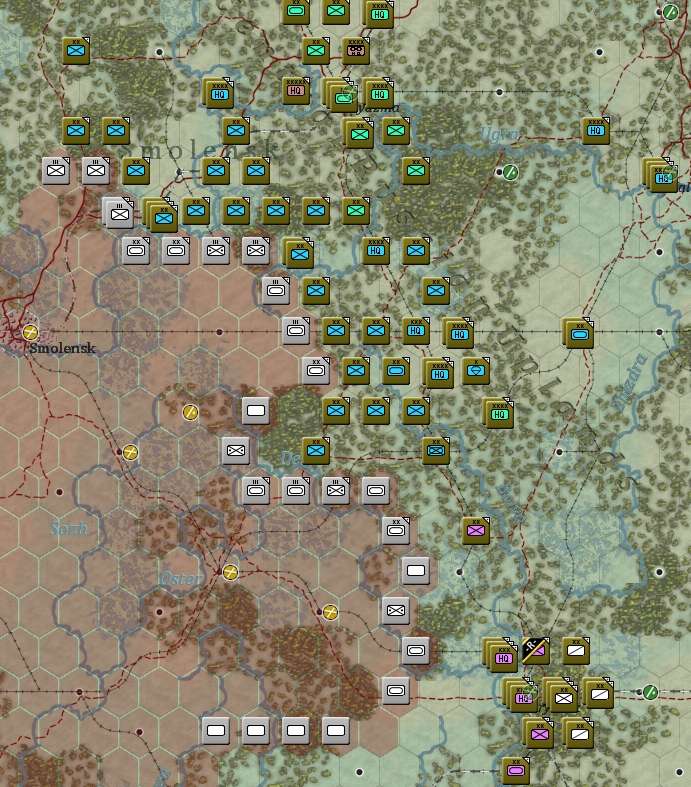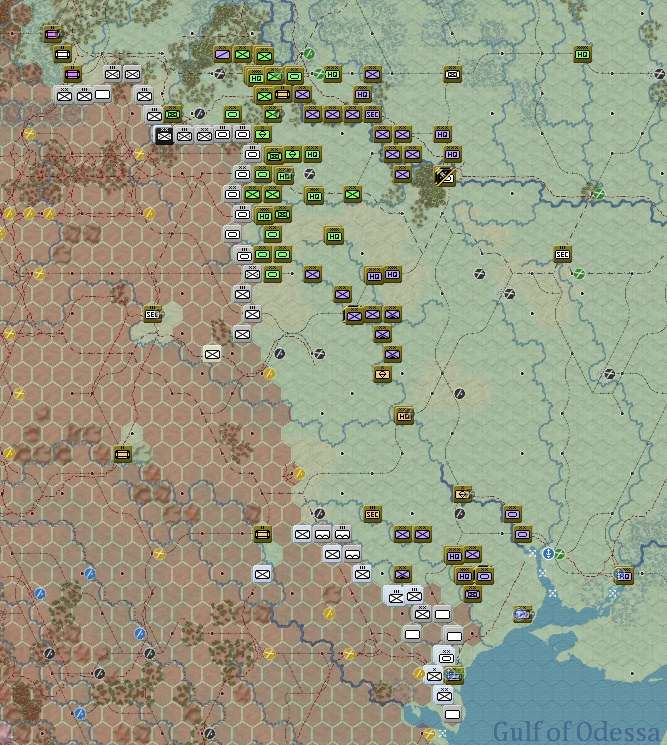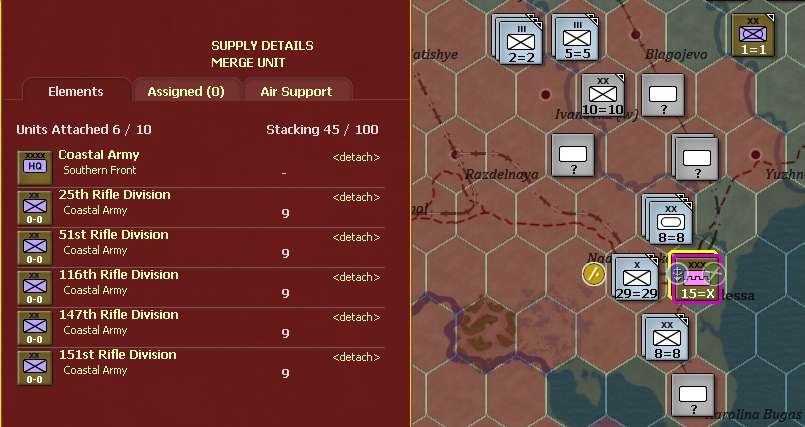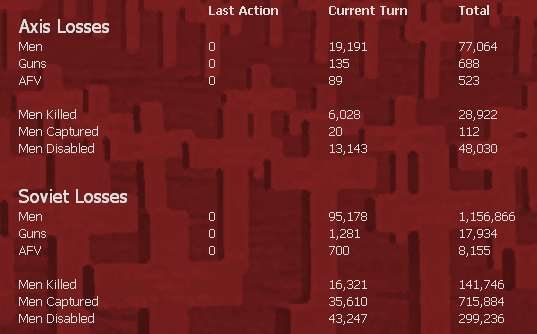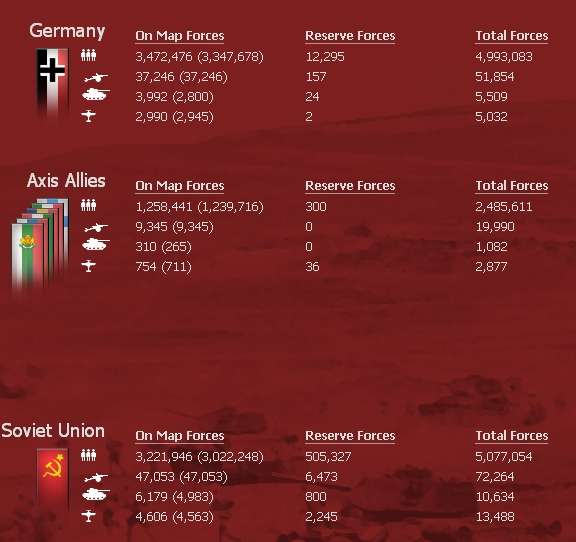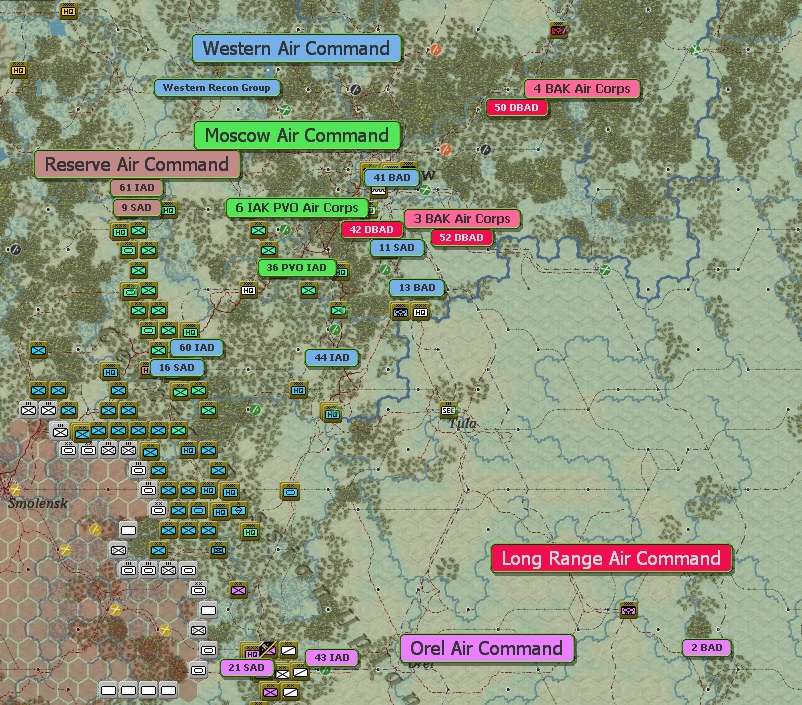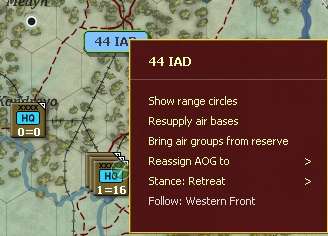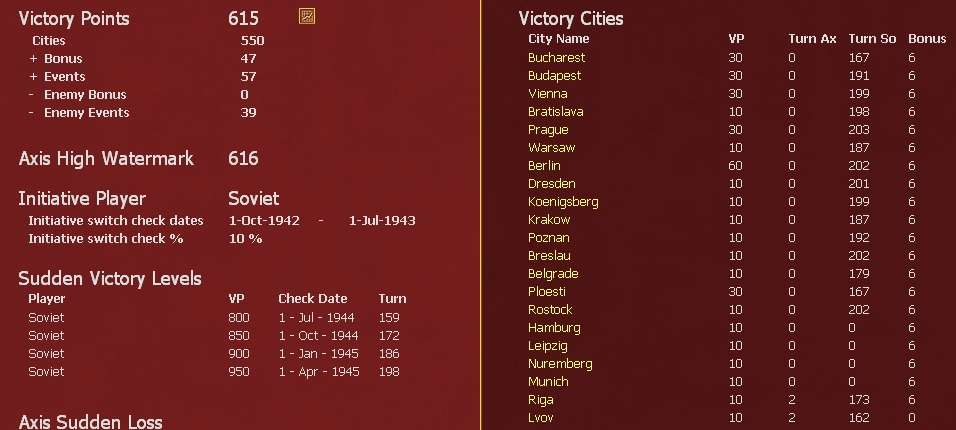4 October 1941
This update is based on the on-map situation at the end of turn 15.
Background
By 10 August, AGN had destroyed the Soviet Luga Operation Group holding the line north of Novgorod and had almost cut the main Leningrad-Moscow railway. AGC launched a major offensive towards Moscow breaking through across a 90 mile front. Fortunately, poor terrain and sustained Soviet resistance limited their gains but by the end of the week over 15 Soviet divisions had been shattered. In the Ukraine 5 Army held Kiev but the Soviet position was threatened as German panzers pushed past Chernigov and tried to cross the Dnepr at Cherkassy [1].
By 17 August, the threat to Leningrad increased as the Germans pushed along the Volkhov. In addition the situation at Moscow worsened as German troops captured Vyazma in heavy fighting against 24 Army. A second German drive made steady gains towards Kaluga. In the Ukraine, Stavka authorised Soviet forces at Kiev to fall back as the two German pincers threatened an encirclement [2]. Odessa fell at heavy costs to the axis forces, especially the Romanians who had lost over 25,000 men trying to capture the city.
The 24 August saw the increasing isolation of Leningrad as it became dependent on a one single track rail line for reinforcements and supply. Elements of NW Front contested every German gain along the Volkhov while Leningrad Front prepared to defend the city itself. AGC’s onslaught slowed as supply problems started to affect their spearheads and Stavka committed almost every available formation to a line from Rzhev to Kaluga. Lacking combat ready formations [3], the Soviet forces in the Ukraine steadily retreated.
By 31 August, a massive German offensive had cut off Leningrad, despite the crisis at Moscow, Stavka pulled an entire army from the reserve to reinforce NW Front and to hold Tikhvin and the Lake Ladoga ports. At Moscow, the Germans were briefly checked and had to divert some forces to clear out a Soviet salient near Yartsevo that was threatening their lines of communication. In the Ukraine, Axis forces captured Kherson and crossed the Dnepr. Elsewhere, all semblance of a front line was lost as Soviet rearguards tried to cling to vital rail junctions to slow the German advance.
September brought some respite at Leningrad. Using the fresh divisions, the German siege was briefly lifted as Soviet troops regained Mga. Briefly, the threat to Moscow also lifted and the main German offensive was an attempt to cut off Bryansk from the south.
14 September saw the Germans seal off land connections to Leningrad again, but a major Soviet offensive regained the west bank of the Volkhov. Soviet cavalry pushed deep into the rear of AGN (4). At Moscow, the Germans hit Reserve Front, capturing Rzhev. The Soviet position at Bryansk was now threatened by 2 pincers as elements of AGC attacked towards Orel. In the Ukraine, the Germans over-ran the last coherent Soviet defensive line and reached the outskirts of Kharkov.
21 September saw a reversal of fortunes at Leningrad. The Soviet Volkhov offensive made more gains while elements of Leningrad Front attacked eastwards, by the end of the week only a narrow 10 mile corridor kept the city isolated. However, the Germans renewed their drive on Moscow inflicting heavy losses on Reserve Front. Further gains north of Bryansk led to the Soviets abandoning the city to avoid encirclement. In the Ukraine, supply shortages rather than Soviet resistance were the main constraint on German advances.
Early-October
Before considering the details, a part of the new UI is the turn summary (you can turn this off if you want) that opens every time you start the game or open a new turn. How much use you make of this will vary according to your focus but it presents a useful overview and gives access to several other screens. I am transferring roughly 3 rifle divisions per turn from refitting in the reserve to the map.
But if you look at the bottom ‘combat unit alerts’ you can see the basic problem I have. About one unit in six is deemed ‘understrength’, 124 units are ‘unready’, 7 depleted and 35 cut off. I actually had only 162 combat ready rifle divisions (and 50 of those had a TOE below 60%). In effect, the Red Army is on the point of collapse.

Which makes the weather very important. Next turn it is estimated it will rain over most of the front. This is very welcome, but will only have a marginal effect on operations. Most of the front will have light mud which increases MP costs and lowers attacking CV but not enough to bring offensive operations to a halt (and has relatively little impact if there are average or good roads in the hex).
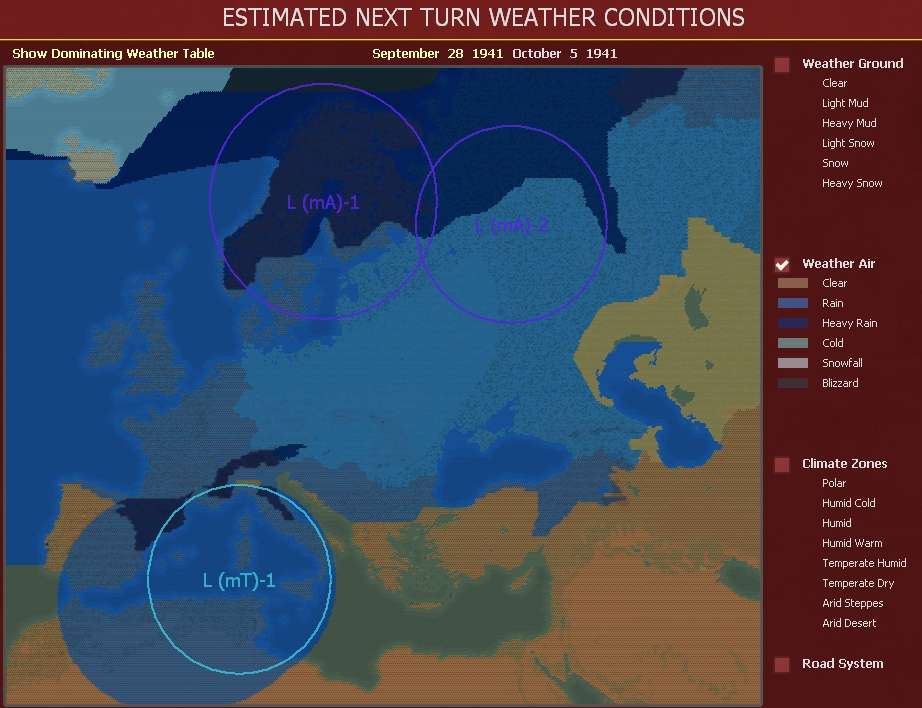 Leningrad
Leningrad
Here, last turn’s Soviet gains brought a robust response. The city is still only isolated by 10 miles, but now that gap is strongly held. NW Front has largely been driven back to its starting position. This makes it increasingly unable to attack again till it has had chance to recover its CPP. One key issue for the Soviets on this sector is it is incredibly hard to bring in substantial reinforcements meaning your front line units weaken over time.
Leningrad itself is strongly held with city forts at Oranienbaum and Leningrad itself. But the current defensive commitment is a finite resource. Again, it is nearly impossible to bring in normal replacements. The only feasible strategy is to allocate Rifle Brigades, convert them to on-map formations and merge them into the existing Rifle Divisions.
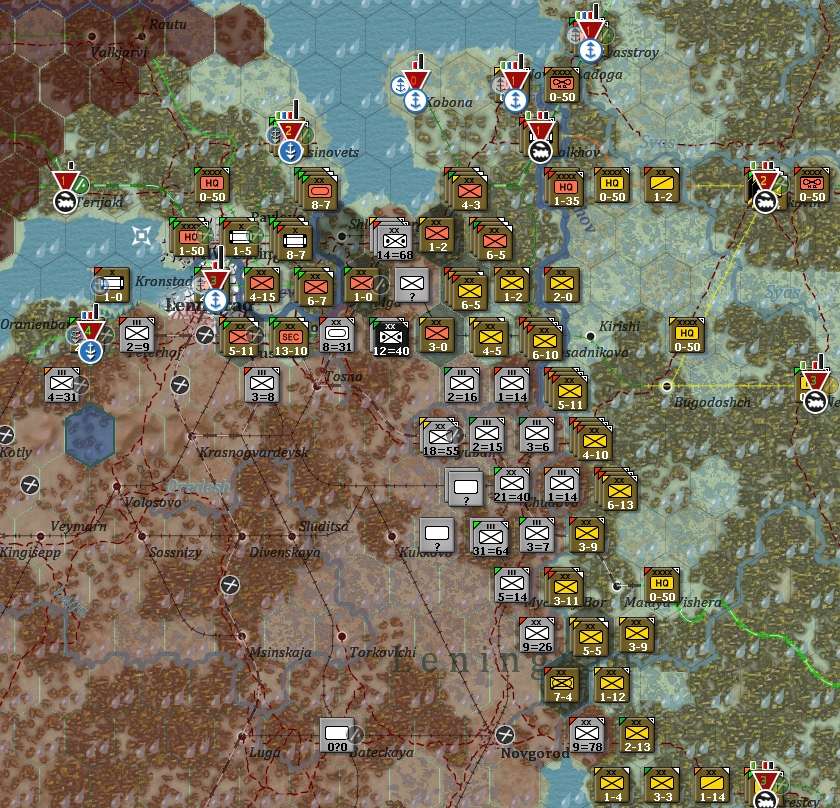 Moscow
Moscow
Here the Soviets have a decent defensive line. The terrain from the current front line to the city itself is terrible, especially the heavily wooded belt. Here the Minsk-Moscow motor road becomes key for both sides – it significantly speeds movement so if the Soviets lose control of it then the Panzers suddenly regain their mobility.
Overall, on this sector, it is easier to pull back weakened units to refit (Moscow itself is a National Supply Source) and return to the front lines so to some extent you can absorb serious losses.
Not shown on the map, but Tula is threatened and that can be an effective route for the Axis to take. Clear terrain and the chance to outflank all that good defensive terrain, and the Oka is likely to have frozen by late November.
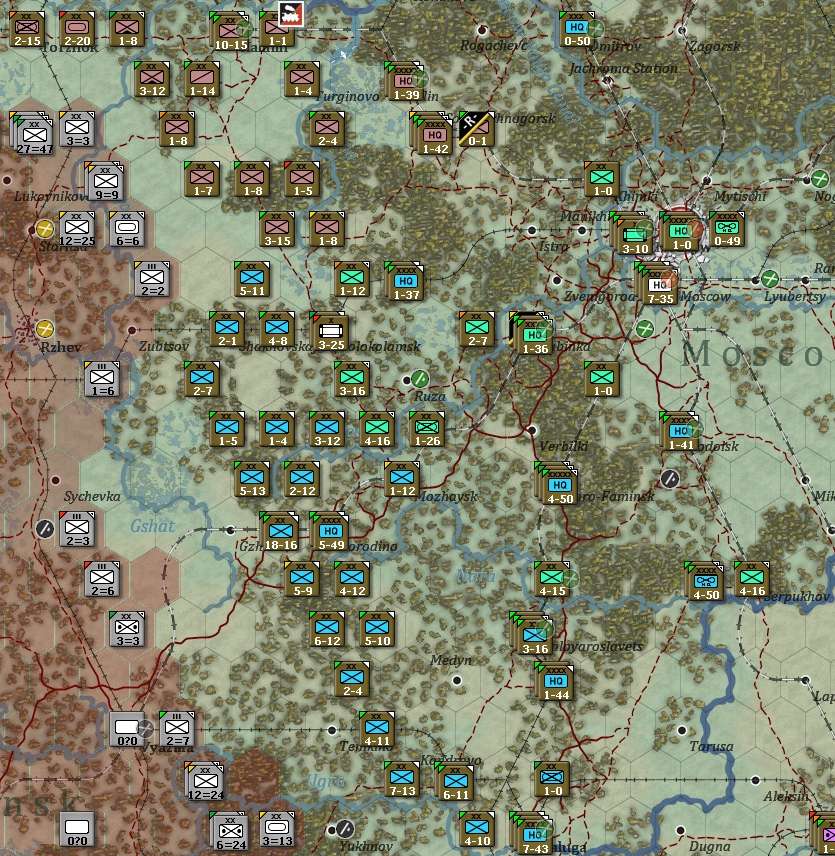 The Ukraine
The Ukraine
The Germans have reached Kursk and Kharkov, Dnepropetrovsk and Zaporezhye are besieged. The appearance of a defensive line is an illusion, most of those units are going to rout if attacked. The only bright spot is the Germans have not attacked into the Crimea and Sevastopol has been turned into another massive fortress.
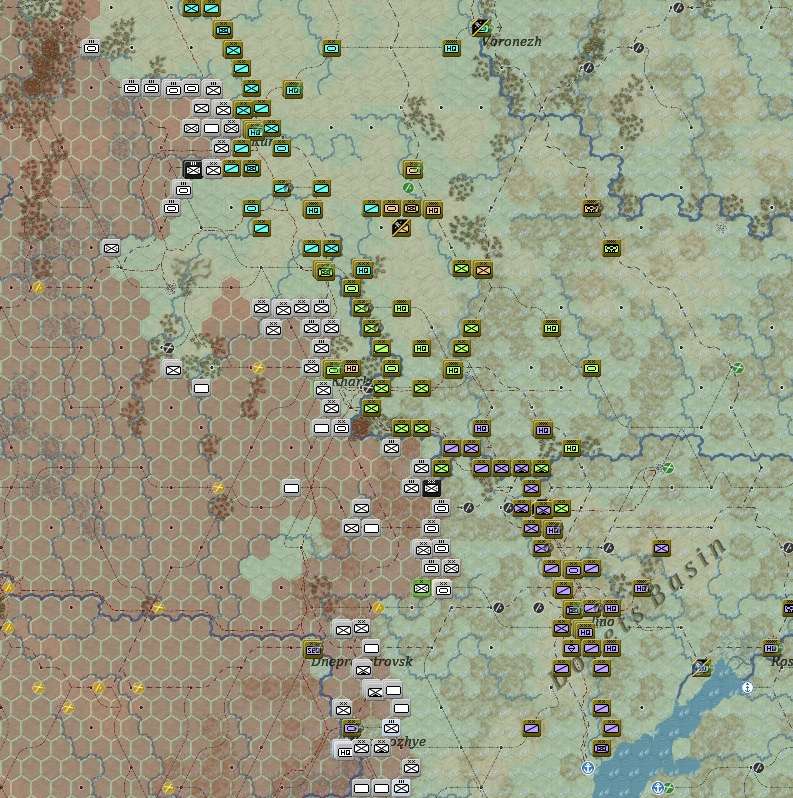
Soviet losses are already over 2.2 million with 1.4 million of those as permanent losses [5].
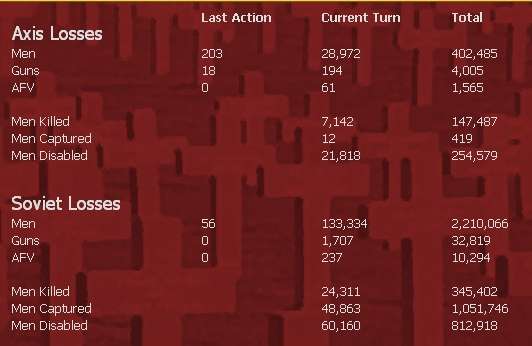
The air war has actually been less disastrous. If the VVS avoids direct engagement with the LW then it can be fairly effective (as it was historically) in 1941. The LW can’t cover everywhere, but the problem is it will be present at the key sectors. For the Soviets it’s a case of take your losses for the occasional reward.
To understand the logic of the phase from now to December 1941 it is useful to review how you win the game, and how actions now can influence the results in May 1945. So the next post will consider winning and losing.
[1] What can be called a bad turn. The loss of the equivalent of 2 armies from Western and Reserve fronts can easily happen when low morale/experience formations are caught in sustained fighting.
[2] Not ideal – this is discussed in the second post about winning the game.
[3] This becomes a major problem for the Soviet player at this phase. Simply being in combat weakens your formations and it is very hard to bring them back to strength.
[4] As the Axis player, be aware of the mobility of the Soviet cavalry, tank and mechanized divisions in this phase, they are mostly fragile but can exploit any gaps in the lines.
[5] Expect to lose over 3 million in 1941 alone.
